Tom,
Thanks, it’s like you read my Dunder Mifflin mind.
I find that most rapid elearning developers are working by themselves or with very small teams. In those situations, their organizations don’t offer a lot of support to learn more about elearning. Typically, there’s no access to more experienced developers or others who can help them grow as an elearning developers.
On top of that, because of time constraints, many organizations aren’t always looking for the best elearning courses. They usually just want something done quickly. That was always my frustration. I wanted to do more, but most of my clients didn’t. So I had to build a lot of the same types of courses and didn’t get many opportunities to flex my wings.
If you’re in the same boat, here are some tips to help make 2010 a good year for you.
In a learning community, the newbies need the experts who provide valuable insight and experience. At the same time, the experts need the new people because they bring a different perspective and can challenge the norms. The worst thing for the community is to become an echo chamber where nothing’s challenged and no new ideas are explored.
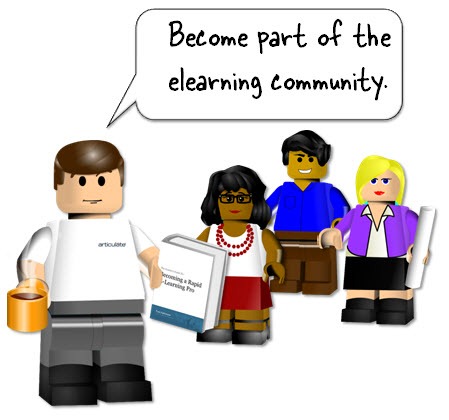
In fact, some of my best personal learning comes when someone less experienced tries to figure out how to solve a problem. It’s something I might never explore if they didn’t ask (or if all I did was hang out with the other experts).
So if you want 2010 to be the year you really kicked your elearning skills into gear, here are some tips on how to join the rapid elearning community. I’m going to share them from my perspective in the Articulate user community, but the ideas aren’t limited to any specific tool.
You can’t be part of the community if you don’t join it. Keep in mind, it’s not entirely a formal process. It’s a combination of formal structure and informal networking. You can join your software’s user community which is usually an online forum. And you can also enter the community by connecting with other elearning people and following them via RSS feed or other social media, like Twitter.
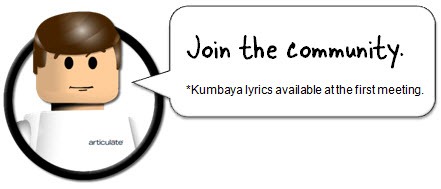
Think of the elearning community as a big cocktail party with little groups of people involved in a bunch of different conversations. Most of the time, we’re observers walking from one group to the next. We listen, but rarely participate. You won’t meet new people at a cocktail party that way, and it won’t work online either. To really be part of the community, you have to be more involved.
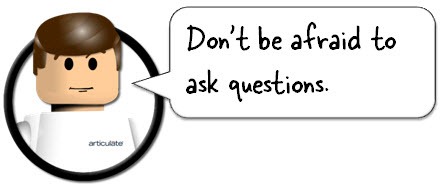
One of the best ways to become accepted in the community is to answer questions. However, the reality is that most people in the community are lurkers who only take information. The next level is the small percentage who will ask questions. And then even fewer will offer answers.
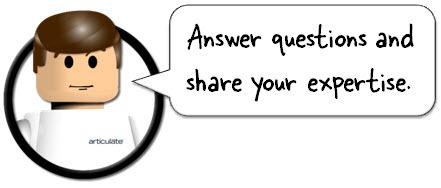
In many cases, we’re all building the same types of courses. Why not share what you’re doing? You don’t need to share any proprietary data, but if you have some good graphics or a PowerPoint template feel free to share it with others. Do you have some Flash skills? Why not share your expertise?
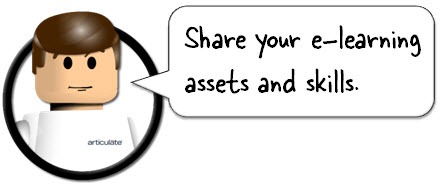
A community of active members shares ideas and assets. Sometimes it produces free assets for the other members. And sometimes it produces opportunities for those who are entrepreneurial.
Here are some recent examples related to the Articulate user community with some freebies to boot:
Those are just a few of the examples of the tangible benefits of the elearning community. Not only do you learn from each other, you also are presented with all sorts of opportunities, and in many cases, free assets for your courses.
Make the community more than conversation about technical support. Share ideas. Talk about things you’ve learned and what you’d like to do. Here are a few recent examples that I think represent the best of what can happen in an active community:
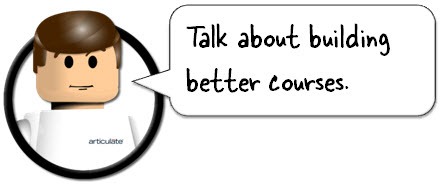
Online communities and social media tools give you access to peers and experts that you didn’t have a few years ago. If you want to develop your skills and build better elearning courses, now’s a good time to get started. Connect with your user community and share what you know. You won’t regret it and you’ll have a great 2010.
What resolutions have you made to help build your skills this year? Share them by clicking on the comments link.
On a side note, I really want to thank all of those who participate in the Articulate user community. I also want to thank our MVPs who do so much to help other users and make our community a great place to learn.
 |
 |
 |
|
Want to learn more? Check out these articles and free resources in the community. |
Here’s a great job board for e-learning, instructional design, and training jobs |
Participate in the weekly e-learning challenges to sharpen your skills |
 |
 |
 |
|
Get your free PowerPoint templates and free graphics & stock images. |
Lots of cool e-learning examples to check out and find inspiration. |
Getting Started? This e-learning 101 series and the free e-books will help. |
Tom,
Thanks, it’s like you read my Dunder Mifflin mind.
[…] the Articulate Community, why not make it a goal to get more involved? Tom Kuhlmann’s post on How to Be an E-Learning Superstar in 2010 is a great place to get some […]
Ok, for my first dumb question. How do I join the community?
Your recent eblog on developing layered training rather than linear couldn’t have been more on-point and on-TIME for me. Shortly after receiving it, a client asked that I develop a course in modules so that various targent audiences could then pull only those items applicable to them. Instead, I used your concept of multiple hyperlinking “buttons” on the slides so the user could follow the path they needed. The client is absolutely ecstatic and I have you to thank!!
These are all great ideas, however, it would be nice to have a “sandpit” where people could, (for example), put examples of work. Not everyone has any web areas/server space available. I just have a PC and my AP’09 suite for example.
Bruce
Tom,
Thanks for sharing this. I agree with Patrick. It is great to know I’m not the only one in my situation of a one person training department with limited resources. You gave me just the inspiration I needed. Looking forward to more great tips from you. Keep up the good and most helpful work.
Hi Tom,
I really love this blog! One of my New Year Resolutions is to become a total expert in the eLearning and Instructional Design profession. Near the end of completing my master’s degree in HRD at NEIU, my professors suggested that we all continue to add to the body of knowledge in the society of “Instructional Design.” I plan to keep my promise. To get there, I want to read more books, blogs, and articles this year to build on what I already know. No doubt, we live in an ever changing world. As we speak, there is a super computer being designed. 🙂 Enough said! That’s why we have to keep learning and sharing. A second goal I’d like to accomplish is to get at least one article published in a training publication. If I accomplish this goal by the end of the year, I’ve met my New Year Resolutions.
Again, great blog. Thank you for sharing!
In trying to develop “scenario based” training I’ve begun using graphic assets, such as stock pictures of people in different situations. Using Photoshop to “cut” out the person without the background is time consuming.
Does anyone know of a good graphics package that would contain photos of people (preferably same people in various positions), backgrounds (offices, workshops, outdoors, etc), and other business-related images? Price is always an issue, but my management was supportive of buying something in lieu of the time I spend “cutting” photos now. Any ideas will be greatly appreciated.
Darrell Bird
It would be great if there was a website that could list the various e-learning communities that are available. For example if anyone lived in the Denver Metro area, there is a group called DMELD (Denver Metro E-Learning Developers)… and it would be great if there was anyone willing to collect these group names and contact information so that individuals who are interested in joining such groups could more easily find them.
By the way, DMELD’s next meeting is a rare networking opportunity for anyone in the Denver area. I highly recommend that you attend if you are in the area! See this link for more information and please RSVP if you are interested!
http://www.evite.com/app/publicUrl/IZKMMFPLOTLYGIFQCKHT/DMELD10thAnniversaryEvent
Tom,
Thanks for all the suggestions of where to look for expert advice. I belong to several instructional technology based communities, but have been looking for an instructional design group or blogs on the subject.
Your blog is terrific! I sent the link to everyone in my professional development group at our county office of education.
-Alix
Thanks again for more great ideas and another thought provoking blog. Since I just beat Lego Indiana Jones and am playing Lego Batman with my 7 year old son, what also jumped out at me was the Graphics :)…. Did you have to get permission to use them?
Keep up the great work!
@Darrell
I had the same frustration as you with cutting out characters. That’s why I started http://www.elearningart.com, as Tom mentioned above. Tom has a link to a free starter pack of my images that you can download and play around with. Here it is again: http://www.elearningart.com/v/vspfiles/email_templates/sign_up2.asp
You can also see the types of characters (mostly business casual professionals in 75+ poses per character with the backgrounds all cutout) and backgrounds (office settings, warehouses, buildings, etc) that I have on my website. I hope this saves you lots of time! 🙂
Bruce,
I bought a cheapy web hosting contract for something like $38/yr that I use as something of a sandbox and as a place to show off a few of the things I’ve built for my job. Buying my own gives me total control and PLENTY of opportunities to learn the web side of stuff.
–Allen
I’m with Scott, where did you find those Lego people?
Great blog,
And, let’s not forget the awesome, the one and only Jeanette Brooks at Articulate for Quizmaker magic.
I follow @jeanette on Twitter, and her Screenr videos are truly amazing. She wraps her creative brain around Quizmaker, and the results are assessment magic.
Since most assessments come at the end of an e-learning course, why not “end with a bang” and give the learners fun, exciting, and challenging quizzes that they’ll remember? (Learning retention… what a concept!)
Follow @jeanette, and look for her Forum posts in the Quizmaker section.
@jenisecook
Correction to Jeanette’s Twitter ID:
@jeanettebrooks
And, to view her Screenr videos on Quizmaker, go to this location:
http://screenr.com/user/jeanettebrooks
@jenisecook
Hi Tom,
I liked your Lego People. Just curious: where did you find the images? Or did you storm your kids room and ‘borrowed’ them?
You post the most helpful hints, tips and advice. Stuff I can and do use right away on active projects. My enduring thanks
Thank you for this post. I think it is much more than about eLearning but succinctly sums up how to become a part of online communities & develop your PLE in a broader sense. Best wishes for 2010, Sarah
Tom,
You mentioned something about a SDK for engage. Where is that located and do you have any more information about it? It would be interesting to experiment with it!
Thanks,
Dean
[…] @lauurent: e-learning superstar in 2010 : http://www.articulate.com/rapid-elearning/heres-how-to-be-an-e-learning-superstar-in-2010/ […]
[…] Here’s How to Be an E-Learning Superstar in 2010 » The Rapid eLearning Blog – Tom Kuhlmann at Articulate prompts a list of avenues for becoming an elearning professional. […]
Happy New Year Tom. Thanks for a great 2009 and looking forward to 2010.
I love the LEGO guys on this. did you make them on that one website?
I am very closely following your great site Thank your article
Hi Tom!
I always enjoy reading your eLearning blog…when I actually have time to read it, that is! That’s my resolution for 2010, to find more time to read and practice eLearning so my courses may improve. One of my challenges is that my corporation has strict labeling guidelines, therefore creativity is limited.
Any advice on that?
-Beth
Hi,
Thanks for all the tips of where to look for expert advice. I belong to software development technology based communities, but have been looking for an instructional design group or blogs on the subject.Thanks for such wonderful posts,i enjoy my online experiance when reading your posts.
Your blog is Excellent!
Thanks
Nevin
[…] This post was mentioned on Twitter by Socialearning, Tyson Priddle. Tyson Priddle said: Here’s How to Be an E-Learning Superstar in 2010 » The Rapid eLearning Blog: http://bit.ly/8Ow4Uy via @addthis […]
[…] Here’s How to Be an E-Learning Superstar in 2010 » The Rapid eLearning Blog […]
First of all, a big thank you to Bryan Jones for the awesome starter kit! Its very very helpful.
Tom, another great blog post. This year I hope/plan/want to concentrate more on making ‘effective’ training materials and not simply make them. Everything is a time crunch, and I doubt if ever there will be a time when the project will run its full course with plenty of time to discuss ideas, implement them, improve them by trial and error. Every new project is a continuous improvement over the previous one. This year I hope to make those small fixes to every course, ‘creatively’, if I can say so. Thank you Tom, for keeping this community alive, you are a great source of encouragement!
I love this blog! I already learned so much from it! Thank you for such great ideas.
[…] Here’s How to Be an E-Learning Superstar in 2010 […]
[…] officially more than half over. It feels like just a few days ago that we were talking about resolutions! And suddenly here we are, smack in the middle of […]
[…] media e come gestire tutti i flussi di informazioni. Abbiamo anche discusso su come far parte della community può aiutarvi a diventare una “e-learning superstar”. Con l’Internet e i social media di oggi, è possibile ridefinire chi è un tuo pari. E questa è […]
I likes Ones style man
0
comments